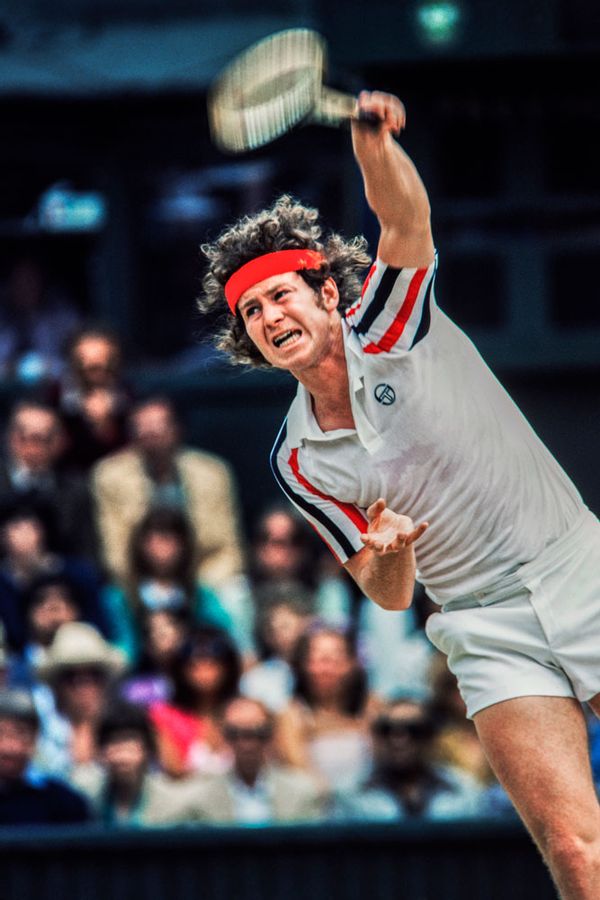Tennis bad boy or perfectionist? Showtime’s “McEnroe” is a candid exploration of a complex star
Ask a group of people who John McEnroe is in 2022 and you’re likely to get at least a few different answers. Tennis fans will no doubt identify him as one of the greatest to ever play the sport as well as one of its top commentators. Gen Z might pick him out as the inexplicable but strangely perfect narrator of Netflix’s coming-of-age comedy “Never Have I Ever.” Others might know him by name and/or reputation only — his outbursts on the court are infamous and solidly preserved in popular culture.
The point is: We all think we know John McEnroe, but Showtime‘s new documentary from writer-director Barney Douglas, titled “McEnroe,” attempts to set the record straight by painting an intimate portrait of a complicated perfectionist whose unmatched skills and intense demeanor carried him to the top of the sport while making him a polarizing figure both on and off the court.
Less a hagiography and more of a dive into the psyche of an elite athlete who, like so many before and after, was thrust onto the world stage at a relatively young age, the hour and 43 minute film is a slyly charming confessional from one of sports’ bad boys. It pairs extensive archive footage and personal home videos with candid interviews with John, his brother Patrick (with whom he often covers tennis matches), wife Patty Smyth, and his adult children. Even fellow tennis greats Billie Jean King and Björn Borg are along for the ride (the latter from his jealousy-inducing lake house), providing their own unique insights into an existence most of us will never and can never understand. The result is a revealing look into the life and career of a man who is much more than the tabloid headlines about him ever suggested. But in some ways, the film could still go deeper.
Set against the backdrop of a single night as McEnroe wanders the streets of his hometown of New York City, “McEnroe” begins like most documentaries do: at the beginning. We learn how John started playing tennis at a young age at a club near his house, how the sport experienced a significant increase in popularity in the 1970s alongside personalities like Jimmy Connors, Ilie Năstase, Vitas Gerulaitis, and, of course, Borg (the hair depicted in this particular sequence is worthy of its own documentary).
From there, it chronicles McEnroe’s rise through the tennis ranks, from his first appearance at Wimbledon as an 18-year-old qualifier in 1977 to his bitter five-set defeat at the hands of Ivan Lendl during the finals of the French Open in 1984. In the minutes between, we’re treated to ruminations on greatness — what it is and what it means — and insight into McEnroe’s friendship with Gerulaitis and rivalries with Connors and Borg (the iconic 1980 Wimbledon final definitely gets its due). There is also significant time spent on McEnroe’s relationship with his father, who eventually became his manager, and the role the elder man played throughout his son’s life.
 John McEnroe (USA) in action with racket raised at The Championships 1980, at The All England Lawn Tennis Club, Wimbledon. (AELTC/Michael Cole)
John McEnroe (USA) in action with racket raised at The Championships 1980, at The All England Lawn Tennis Club, Wimbledon. (AELTC/Michael Cole)
The film does all of this with a cheeky sense of style. There’s almost a “Succession”-like quality to the opening credits, and the graphics throughout that mimic or reflect McEnroe’s temper are certainly goofy, but they also make sense in the context that this is a documentary about a man known primarily for his explosive personality (if anyone can get away with using VFX of a thunderstorm brewing in the desert, it’s probably John McEnroe). Meanwhile, the sound editing during the 1984 French Open sequence probably deserves an award for the way it fully immerses viewers in the experience.
But if there is a flaw in “McEnroe,” it’s one that affects too many documentaries like this one: It attempts to fit a lifetime into a runtime shorter than the most recent “Stranger Things” finale. Despite its subject’s willingness to be forthcoming about his life, his frustrations, his famed on-court antics, and even his drug use (“Cocaine . . . let’s just say it didn’t help,” he deadpans at one point), there is still a lot that feels left unsaid.
As one of the greatest tennis players of all time (which is saying something given that we’re living in a world in which Roger Federer, Rafael Nadal and Novak Djokovic have taken the sport to new and ridiculous levels), McEnroe likely would have benefited from having more time to dig into the thrilling details of his storied career, especially since much of what is known about him, especially by younger audiences, is just the headlines. A 10-episode docuseries à la “The Last Dance” is not necessary, but to limit McEnroe’s swift rise, eventual fall, and the shockwaves that reverberated throughout his personal and professional lives to anything less than, say, the runtime of “Avengers: Endgame,” means much will have to be left out.
When you’re trying to unpack a man’s life and career with the intent of understanding his psyche — especially a man as complex as McEnroe, who was once referred to as “Superbrat” by the British tabloids but is now one of tennis’ most respected pundits —seeing the changes that took place over time is key to understanding the man. So despite being an entertaining celebration of a sports prodigy that will appeal to a variety of viewers, “McEnroe” doesn’t quite feel complete.
The good news is, what is included in the film makes for a captivating viewing experience, especially the time spent on McEnroe’s relationship with Borg. Known as Fire and Ice because of their vastly different demeanors on the court, their rivalry provides something of a backbone to the middle of the chronological documentary, as we relive various matches and the ways in which they pushed one another to be the best until the timeline finally reaches Borg’s sudden retirement at the age of 26 in 1983. His abrupt departure from the sport left a void that affected McEnroe greatly, and the fact that Borg agreed to be interviewed for the film reveals as much about his personal relationship with McEnroe today as it does about their fierce battle on the court decades ago.
Want a daily wrap-up of all the news and commentary Salon has to offer? Subscribe to our morning newsletter, Crash Course.
Meanwhile, the interviews with McEnroe’s adult children remind us of a world that we, the public, have never been privy to: the private life of a celebrity that continues long after the match is over or the cameras stop rolling. And it’s these fresh, revealing moments that make “McEnroe” truly worth one’s time, as we see how its formerly controversial subject’s actions and relationships affected their lives and their relationship with him, too. They ultimately remind us that no matter what we thought we knew about him, we never quite knew John McEnroe. And while we might know a bit more now, there’s still so much we’ll likely never quite understand.
“McEnroe” is currently available on Showtime on demand/streaming and premieres Sunday, Sept. 4 at 7 p.m. ET on Showtime. Watch a trailer, via YouTube.
Read more
about tennis


